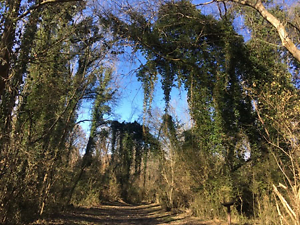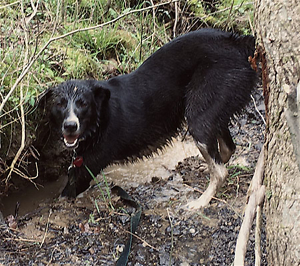Dog in the Bottoms
A four-legged role model shows me how to live in the moment
Nearly every day I take my young dog, Zolene, for a walk in Shelby Bottoms, Nashville’s nearly 1,000-acre refuge for watery creatures and plants.
 A tidy girl with a black-and-white coat, Zolene is affectionate, smart, and tireless. Sometimes we go to the dog park, but we prefer the swamp, where we walk 2-4 miles through the mud and muck. With Zolene, I have now walked every mapped trail in the park, and even a few that aren’t on the map.
A tidy girl with a black-and-white coat, Zolene is affectionate, smart, and tireless. Sometimes we go to the dog park, but we prefer the swamp, where we walk 2-4 miles through the mud and muck. With Zolene, I have now walked every mapped trail in the park, and even a few that aren’t on the map.
One day in early December, we head into the park from an entrance off Tiffany Road in a hive of new tall, skinny houses. We curve down the concrete path to the sound of hammering and electric drills. We pass the tiny dog park where Zolene sometimes finds a playmate, though on this day it is empty. Still, she always wants to go in to make sure. So we go in and then out again.
Back on the concrete path, we pass the turnoff to the old Cornelia Fort Airport and turn right at the next intersection, onto the unpaved Cornelia Fort Trail, a main artery that runs almost from one end of the park to the other.
At a point where the trail snakes around one of its many swampy places, we turn onto an unnamed side trail. A couple of orange ribbons along the half-mile are all that mark the path through deep layers of fallen leaves and rotting branches. The leaves are beaten down enough to make the path plain, though I rarely see another soul on this path.
I release Zolene, which is not officially allowed, although many other dog owners let their canine buddies off-leash back here on the natural trails. She’s off like a shot, joyfully tearing through the bottomland — leaping, barking, twirling. She finds mud holes where she digs passionately, squeaking and yipping. She looks up at me as I pass, mud dripping from her face. Then with a flick of the white tip of her tail she’s off again, top speed.
Along this trail and the narrow Bottomland Trail it connects to, I drift off into the ether. The first few times I walked these narrow trails I was on constant alert, looking for danger in every direction: coyotes, murderers — both have been confirmed in Shelby Bottoms.
But now I have lost that wariness. I wake up and realize from my MapMyWalk app that I’ve gone a quarter-mile with no consciousness of anything but my own repetitive, circling thoughts, chewing at new bones, old bones, arguing with other people or myself.
I look for Z and see the white tip of her tail flickering in and out of the underbrush.
I walk on and once again drop into my rat cage — reliving ancient arguments with my mother who has been gone for 40 years, making lists of things I need to buy at the grocery store on the way home, wandering through memories that range from the deep past to this morning.
Each time I regain consciousness, I look for Zo’s white tail. Usually, I spot it flicking back and forth — ahead of me, to the left, to the right, sometimes behind.
If I don’t see that waving beacon, I call. Soon I hear, then see her racing toward me at full speed, 45 pounds of solid enthusiasm. Thankfully, she has learned not to knock me flat in the exuberance of her return. It took a while, and I learned to dodge before she learned not to deck me.
After an ecstatic reunion, she’s off again. She dances. She leaps. She pounces. She digs, pulling vines out of the earth by their soaking roots.
Along the Bottomland Trail, getting close to the Cane Break Trail, the trees are taller. In early winter the vines that festoon the trees stand out dark green against the gray and brown forest. While Zolene runs, the vines drag relentlessly at the sweetgum and wild cherry trees. The fallen leaves begin their long journey into mulch. The wind plays ocean in the treetops. Beneath the struggle between tree and vine, young trees and bushes push up, spread their branches, sprout leaves that glow like gold in the weak sunlight.
 Bottomland is all about understory. The successors to the giant sycamores and oaks already have their roots in the rotted carcasses of previous generations. They strain relentlessly to reach the light. But the vines are waiting for them, ready to wrap their wire-hard tendrils around new hosts.
Bottomland is all about understory. The successors to the giant sycamores and oaks already have their roots in the rotted carcasses of previous generations. They strain relentlessly to reach the light. But the vines are waiting for them, ready to wrap their wire-hard tendrils around new hosts.
Suddenly I am awakened again by a burst of mad barking. I hurry toward the sound, thinking coyote. Instead I find Zolene barking furiously at a six-point buck. Not impressed, he looks down his nose at her as if saying, “Whadda ya want, pipsqueak?”
I call her away from this monarch of the forest. We make our way back on the Cornelia Fort Trail, which seems like a safe suburb after our narrow, lonely path. I put her back on leash. She bites it and tries to play the pull game. Instead I wrap it around her body. Sulking, she walks somewhat normally by my side.
As we come back out onto the concrete path, we both stop, shocked by the sight of six men in uniforms, three on each side of the road, dragging big white pieces of plastic behind them.
Zolene stops, stares, bristles and barks, one quick warning.
At first, I thought they were going to try to hang glide with those white plastic sheets or fly them like kites. It was windy, but I realized those options were ridiculous.
I asked the one nearest what they were doing.
“Dragging for ticks,” he said. “The white attracts them.”
That brought me back to the moment with a bang. A thousand acres of dense, swampy woodland, and yet they were seining for ticks in an environmentally conscious way, along a tiny part of the whole that humans and their dogs traverse.
Just as I seine through my memories, seeking out the most biting and bloodthirsty, and brooding on them, pointlessly. Mired in a tiny part of the whole of my experience, oblivious to the wonder of each step, each shadow, each smell that Zolene is so intensely (and literally) immersed in. Maybe I should plunge my head into the mud holes alongside her, to hell with the ticks.
But I think better of it and watch the strange tick hunters disappear down the trail we have just traversed.
I let Zolene loose to jump into the little stream nearby, to wash the mud away. I don’t have to ask her twice.
***
Postscript: More than a week after our block of East Nashville was crushed by the March 3 EF-3 tornado, I returned with Zolene to Shelby Bottoms to check on the damage. For the first mile and a half, I thought the Bottoms had escaped unscathed. But as we headed down the Bottomland Trail, I began to see debris — shingles, hunks of roof, twisted metal, and the ubiquitous pink fiberglass insulation. Then I came to the proof of a force more deadly than slow strangulation: Nearly every tree was down in a small, contained section of the trail, ripped to shreds by the tornado I now visualize as a banshee riding a winged feral hog.
Blocked by the fallen trees still wrapped in vines, I turned back to Cornelia Fort Trail, then the Cane Brake to the end, or beginning, of the Bottomland Trail. The entrance was as it has always been since I’ve been walking there, every festoon of hanging vines in place. But only a few feet in, twisted carnage again blocked my way. The banshee had done her work. But this is a bottomland, and these things happen. Birds were singing.

Copyright (c) 2020 by Lyda Phillips. All rights reserved. Lyda Phillips is a veteran journalist who grew up in Memphis and has earned degrees from Northwestern, Columbia, and Vanderbilt universities. The author of two young adult novels, she worked for United Press International before returning to Nashville.

